
September is National Hurricane Preparedness Month, and this year’s theme is “Prepare to Protect. Preparing for disasters is protecting everyone you love.”
Every week in September, we will be sharing information demonstrating how individual and household preparedness can make a difference in your community. This week’s topic is: Low Cost, No Cost Preparedness.
Disaster preparedness can feel like a massive burden. By taking the time to prepare all-year round rather than right before a disaster strikes or during the time of year when disasters regularly occur in your community (such as hurricane or wildfire season), you can lessen the impact on your time and your wallet.
Beginning in January, do one or two preparedness activities every month. Make a list of everything that your household needs to do, and stick to a regular schedule. This will help make preparedness a regular part of your household’s routine, and alleviate the anxiety and stress surrounding preparedness right before an event. It also allows you to budget preparedness ahead of time.
There are numerous actions you can take year-round to prepare that are low or no cost. These include:
- Set aside at least $10 a week in cash, and put it into an envelope in your emergency kit.
- Purchase one or two items per month to complete your emergency kit.
- Make physical or digital copies of your important documents (such as IDs, birth certificates, health records, insurance records, home ownership records, etc.).
- Make a list of items on porches or outside of your home that need to be brought inside or secured before a disaster, and create a step by step plan to address them.
- Keep your gutters regularly cleaned and secured.
- Trim branches and clean up garbage around your property to prevent it from becoming projectiles in a wind-based disaster (such as a hurricane or tropical storm).
- Contact churches or nonprofits in your area, and ask what preparedness resources they provide both before and after a disaster so that you know where you can go for services.
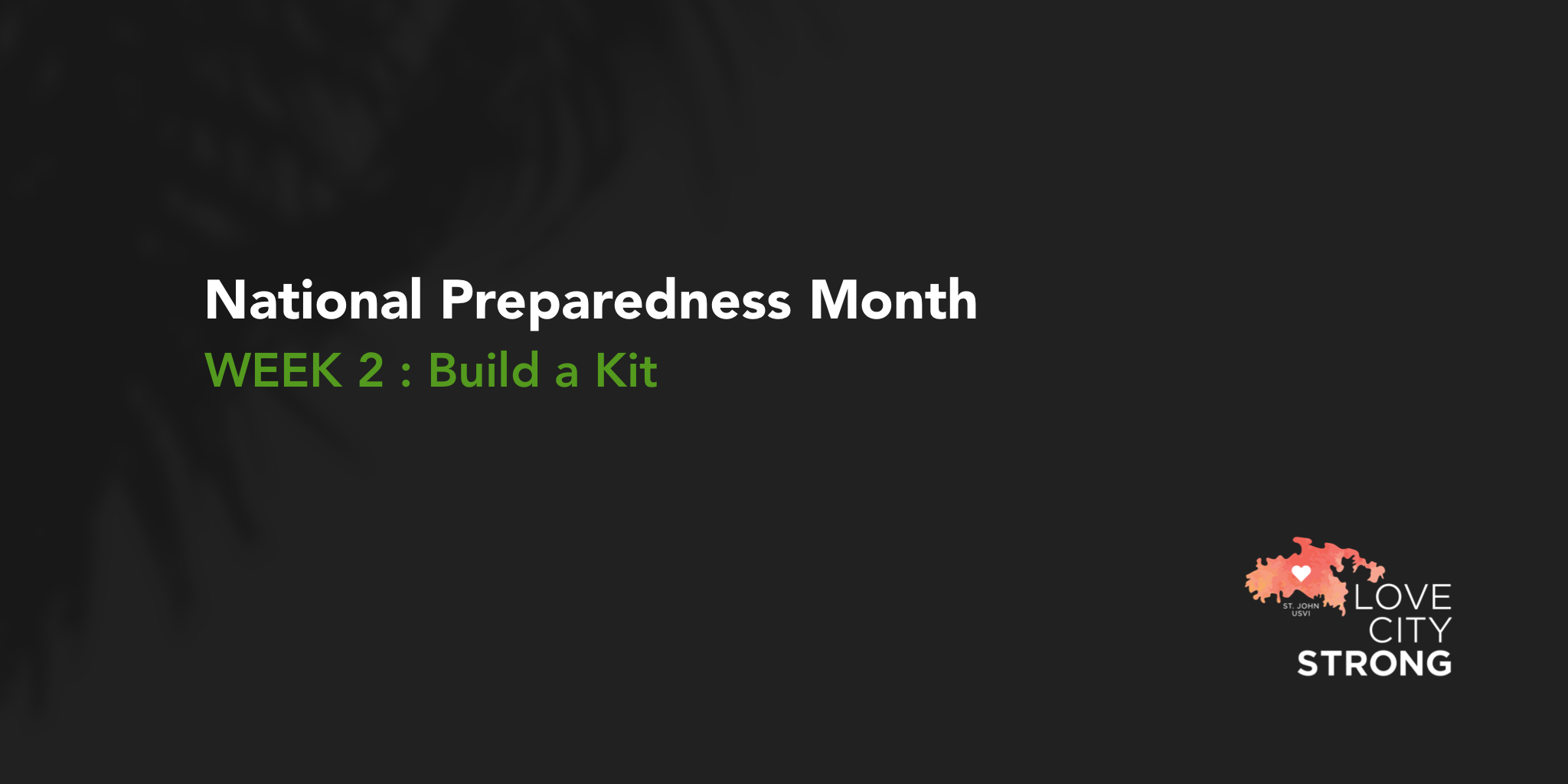
September is National Hurricane Preparedness Month, and this year’s theme is “Prepare to Protect. Preparing for disasters is protecting everyone you love.”
Every week in September, we will be sharing information demonstrating how individual and household preparedness can make a difference in your community. This week’s topic is: Build a Kit.
An emergency kit should include everything that you and every person in your household needs to survive without electricity, access to essential services, and access to your belongings or home for a minimum of seven days.
Non-perishable food, water, medications, first aid supplies, alternative power sources, and copies of your important personal documents are just a few of the essential components that make up a strong emergency kit. Check out the Love City Strong preparedness shopping list to get started.
Every emergency kit is unique. Your kit should feature the basics needed for survival as well as any items that will make you and those living in your household feel safe and comfortable, both during and after a disaster. This could include everything from toys for children, your favorite book, a deck of cards, or a sketchbook or journal.
With the COVID-19 pandemic still impacting communities around the world, your emergency kit should also include pandemic-essential items to keep your family safe. Extra masks, a digital thermometer, hand sanitizer, and surface cleaning supplies should all be included in your kit.
If you have pets, create a separate emergency kit for them as well. Visit the Humane Society’s pet preparedness guide for everything you need to know about creating a strong kit for your pets.
Don’t wait—Start preparing today! For more information on how to build an emergency kit, including downloadable kit lists, videos, and activities to get children involved in the preparation process, visit www.ready.gov/kit.
For up to date, reliable forecasts, visit the National Hurricane Center website. For Virgin Islands specific alerts, watches, and warnings, visit VITEMA’s website, or sign up for AlertVI.
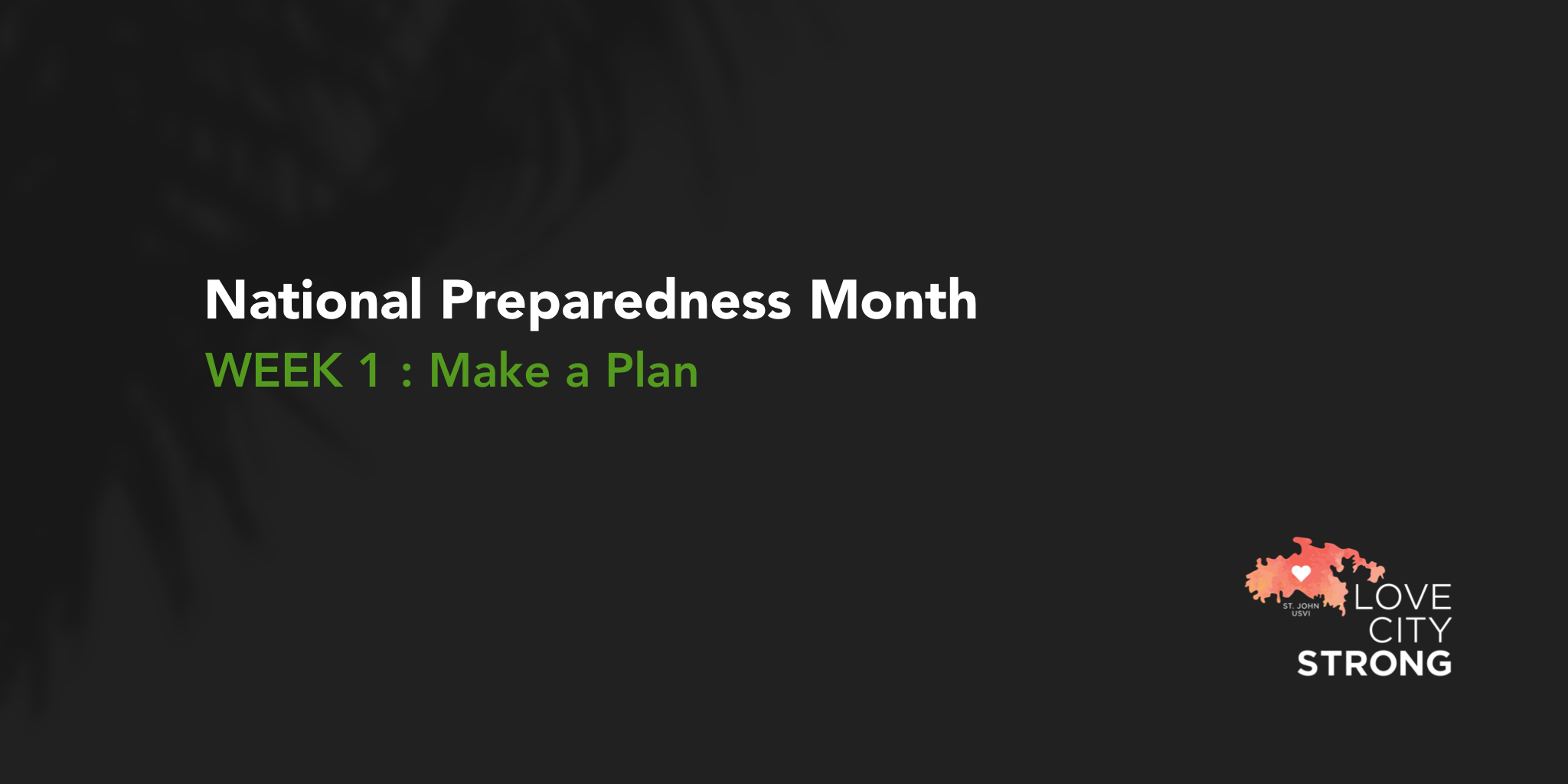
September is National Hurricane Preparedness Month, and this year’s theme is “Prepare to Protect. Preparing for disasters is protecting everyone you love.”
Every week in September, we will be sharing information demonstrating how individual and household preparedness can make a difference in your community. This week’s topic is: Make a Plan.
An emergency plan is a detailed, written plan describing what you and the members of your household will do in the event of an emergency, where you’ll go if you cannot shelter in place or if your home becomes compromised, and establishes a method of communication with your loved ones.
The act of writing an emergency plan down and talking through it out loud with the members of your household can give your loved ones a greater sense of control, and can help manage any fear and anxiety they may have about potential disasters.
After finalizing your sheltering and backup sheltering plan with your household, inform your neighbors and loved ones who live in the same community about your plan. This saves valuable time for first responders who are checking on people after a disaster, and gives your local loved ones peace of mind that you will be safe.
Call your loved ones outside of your community, and let them know what your emergency plan is. Appoint one person who lives outside of your community to be your post-disaster Point of Contact (POC).
Give your POC a list of all of your other loved ones who live outside of your community, and their phone numbers. Put your POC in charge of calling everyone on the list to let them know that you are safe after a disaster. That way, you only need to make one phone call to your POC after a disaster. This will save time, resources, and cellphone battery if there is prolonged power loss or damage to communication services.
Having an emergency plan is critical to ensuring that your family is more prepared for potential disasters. The more prepared that your household is, the less reliant on post-disaster services you will be. Your time and energy can be spent helping others once your post-disaster circumstances have stabilized.
Don’t wait—Start preparing today! For more information on how to create a written emergency plan, including downloadable plan templates, videos, and activities to get children involved in the preparation process, visit www.ready.gov/plan. For up to date, reliable forecasts, visit the National Hurricane Center website. For Virgin Islands specific alerts, watches, and warnings, visit VITEMA’s website, or sign up for AlertVI.
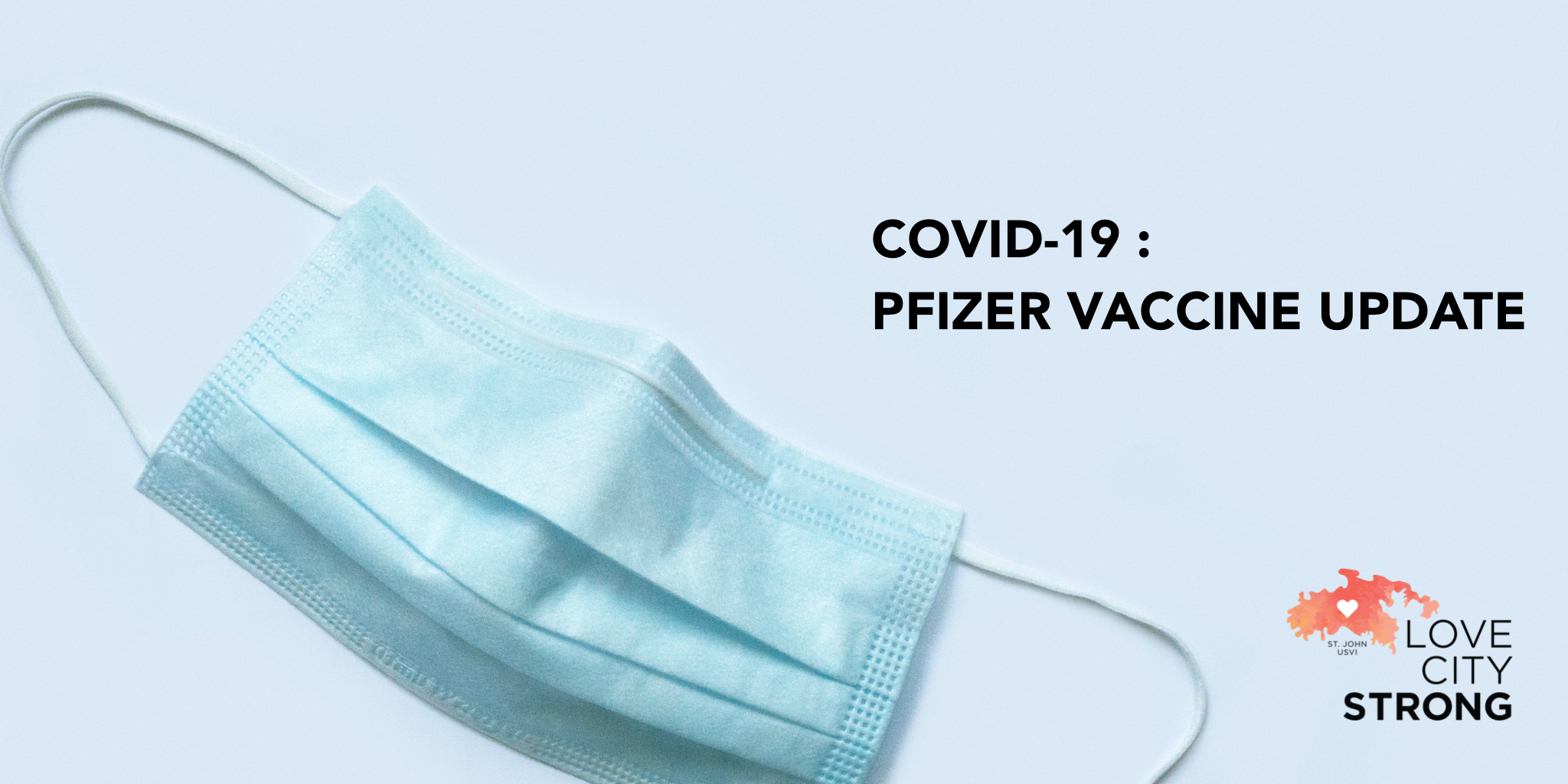
On Monday August 23, the US Food and Drug Administration (FDA) gave its full approval of the Pfizer-BioNTech COVID-19 vaccine.
According to their press release: “ ‘The FDA’s approval of this vaccine is a milestone as we continue to battle the COVID-19 pandemic. While this and other vaccines have met the FDA’s rigorous, scientific standards for emergency use authorization, as the first FDA-approved COVID-19 vaccine, the public can be very confident that this vaccine meets the high standards for safety, effectiveness, and manufacturing quality the FDA requires of an approved product,’ said Acting FDA Commissioner Janet Woodcock, M.D.”
Pfizer’s vaccine is fully approved for people ages 16 and older. For those who are ages 12 to 15, and for those who are immunocompromised and may need a booster shot, the vaccine is still available under the FDA’s emergency use authorization (EUA).
Pfizer and BioNTech applied for full approval of their vaccine in May 2021. The process of final approval requires an analysis of the drug’s benefits, its risks, and six months worth of peer reviewed data from the manufacturer’s clinical trials (in this case, over 40,000 individuals around the world).
Much of this process was already done as a prerequisite when the FDA authorized the vaccine’s emergency use. Due to the urgent health risks to individuals caused by the pandemic, the full approval process then fell into what the FDA refers to as a “Priority Review.” The typical length of time for products falling under Priority Review is six months. With much of the data analysis done on the front end, the full approval process took four months.
The FDA’s announcement comes as the COVID-19 Delta Variant continues to spread across the globe. Many communities are hitting record high numbers for infection rates and hospitalizations, including the Virgin Islands.
The vaccine remains the most effective way for individuals to protect themselves and others against the ill-effects of COVID-19. To learn more about the COVID-19 vaccine, visit the VI Department of Health’s resource page; the CDC’s Vaccine FAQ page, and the Johns Hopkins guide for fully vaccinated individuals.
You can also check out our vaccine Q&A with Sandy Colasacco, a Board Certified Family Nurse Practitioner and the Clinical Executive Director of Island Health and Wellness.
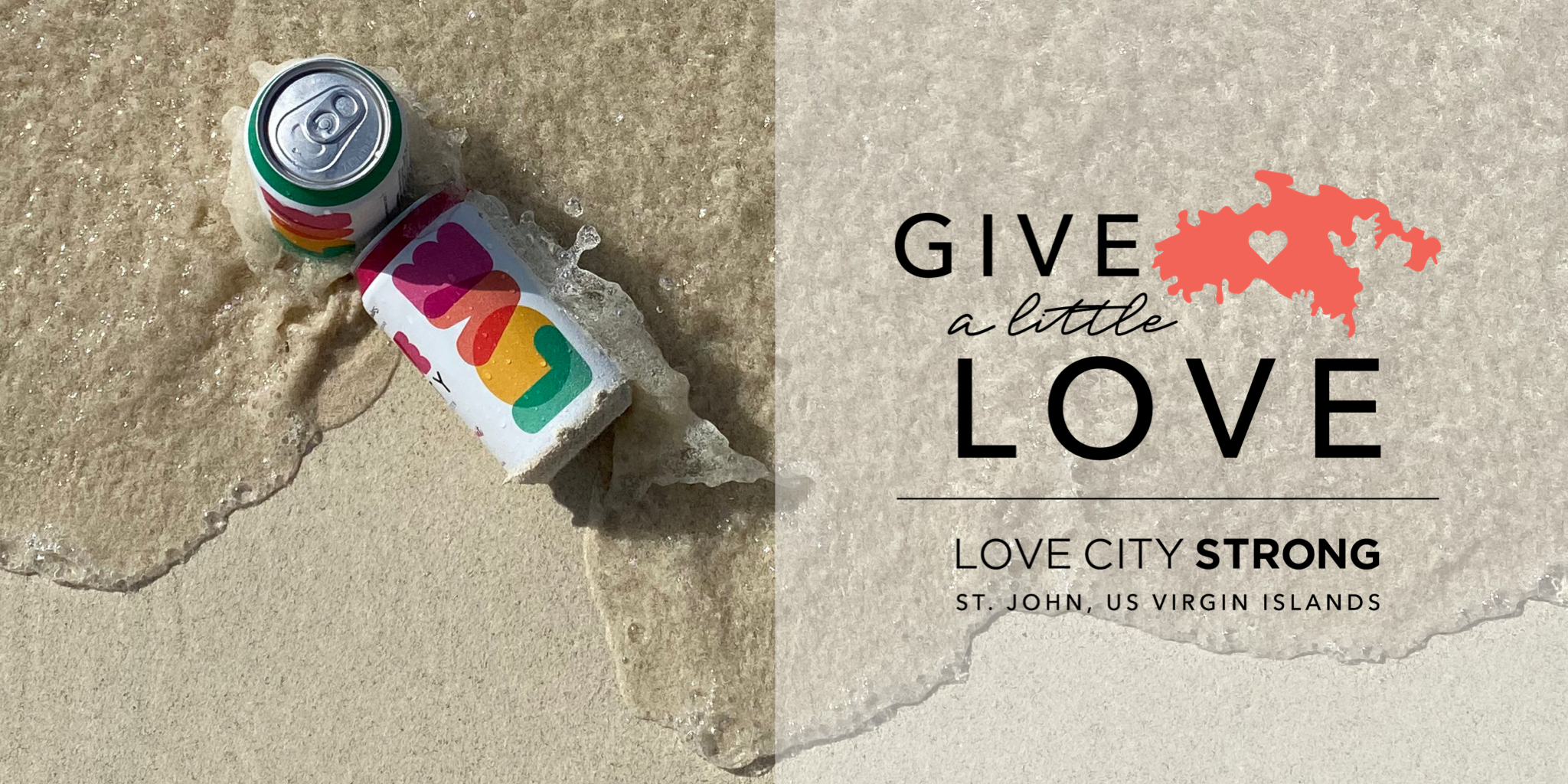
During the month of August, “Give a Little Love” when you visit the Tap Room! For the entire month, each time you purchase a can of St John Brewers’ Love Hard Seltzer from the Tap Room or the Brewtique, a portion of the sale will support Love City Strong’s disaster preparedness and recovery programs on St. John.
As we enter the peak of hurricane season our preparedness efforts are more important than ever. In addition, recovery from the 2017 hurricanes is ongoing, and the journey is made harder for many due to the pandemic.
St John Brewers is a long time supporter and partner of LCS. Their team is always ready to help the community, and we’re proud to partner with them on this fundraiser. If you’re on St. John, please go by and purchase some Love Hard Seltzer and give a little love back to our community! If you’re not on island but still want to contribute, please visit our website to make a donation.
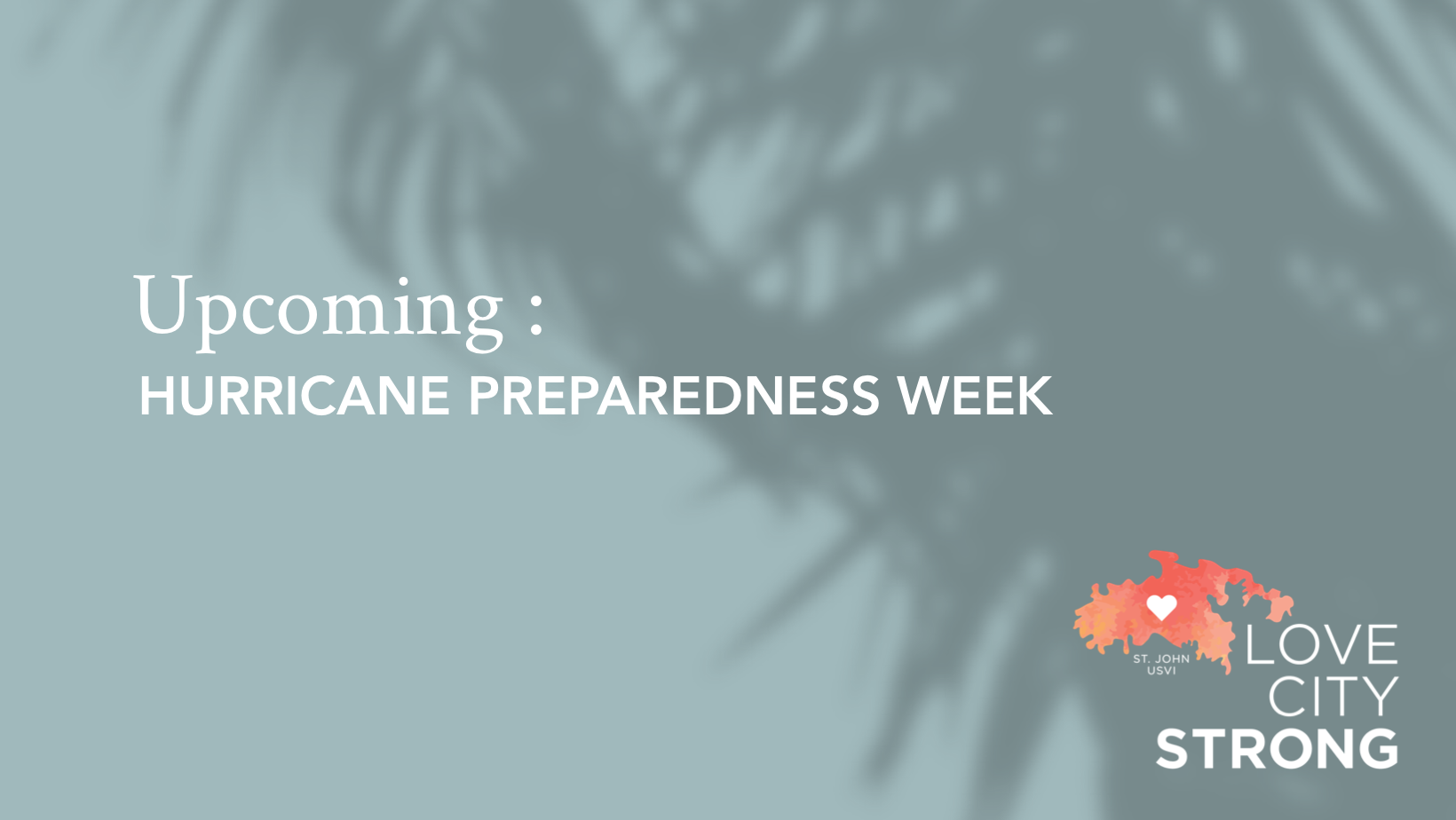
Disaster preparedness is at the very core of Love City Strong’s mission. Importantly, each May we highlight Hurricane Preparedness Week – this year, from May 9th through 15th. The week serves as a perfect time to assess your personal hurricane risk and preparedness. Predictions indicate an above average activity level this season but clearly, it only takes one storm to change your community.
Before hurricane season begins on June 1st, you should begin doing the following things:
- Determine your risk
- Develop your sheltering or evacuation plan.
- Assemble disaster supplies, or “Build A Kit” as Ready.gov says!
- Get an insurance check up
- Strengthen your home
- Help your neighbors
- Complete a written plan

From March 8-12, you can support LCS by donating through the GlobalGiving Foundation’s #LittleByLittle campaign! When you donate up to $50 via our GlobalGiving page this week, the Foundation will match your generosity up to 50%!
At Love City Strong, addressing the impact of disasters on the St. John community is our primary mission. Therefore, our projects either focus on addressing these issues in the aftermath of an incident, or preparing for them before they may arise.
Click here to donate to us via GlobalGiving, and to have your donation matched: http://bit.ly/3pAmrMc
The #LittleByLittle campaign was created by GlobalGiving in 2019. It addressed concerns from donors that small donations may not seem to have much of an impact. In fact, according to the people who work for and with nonprofits around the world, the opposite is true!
Subsequently, to highlight the idea that little acts of kindness make a BIG difference, the #LittleByLittle campaign was born.
At LCS, we benefit a lot from small donations. We have always believed that even the smallest acts of generosity make a difference in the long run. Just as our larger donors get our projects off the ground, in the same way small donors are the ones who keep these projects moving.
Smaller donations help us fund the little, everyday things that we need to successfully run a nonprofit organization. There are many incremental expenses, for instance, stamps, or masks and hand sanitizer for employees and clients. There is no donation that is too small, and every single contribution matters to us on a daily basis.
We hope that you’ll consider supporting LCS through the #LittleByLittle campaign this year. To donate and have your donation matched, be sure to visit our GlobalGiving page http://bit.ly/3pAmrMc.
Thank you to all of our donors, big and little. Truly, your continued support makes a difference!
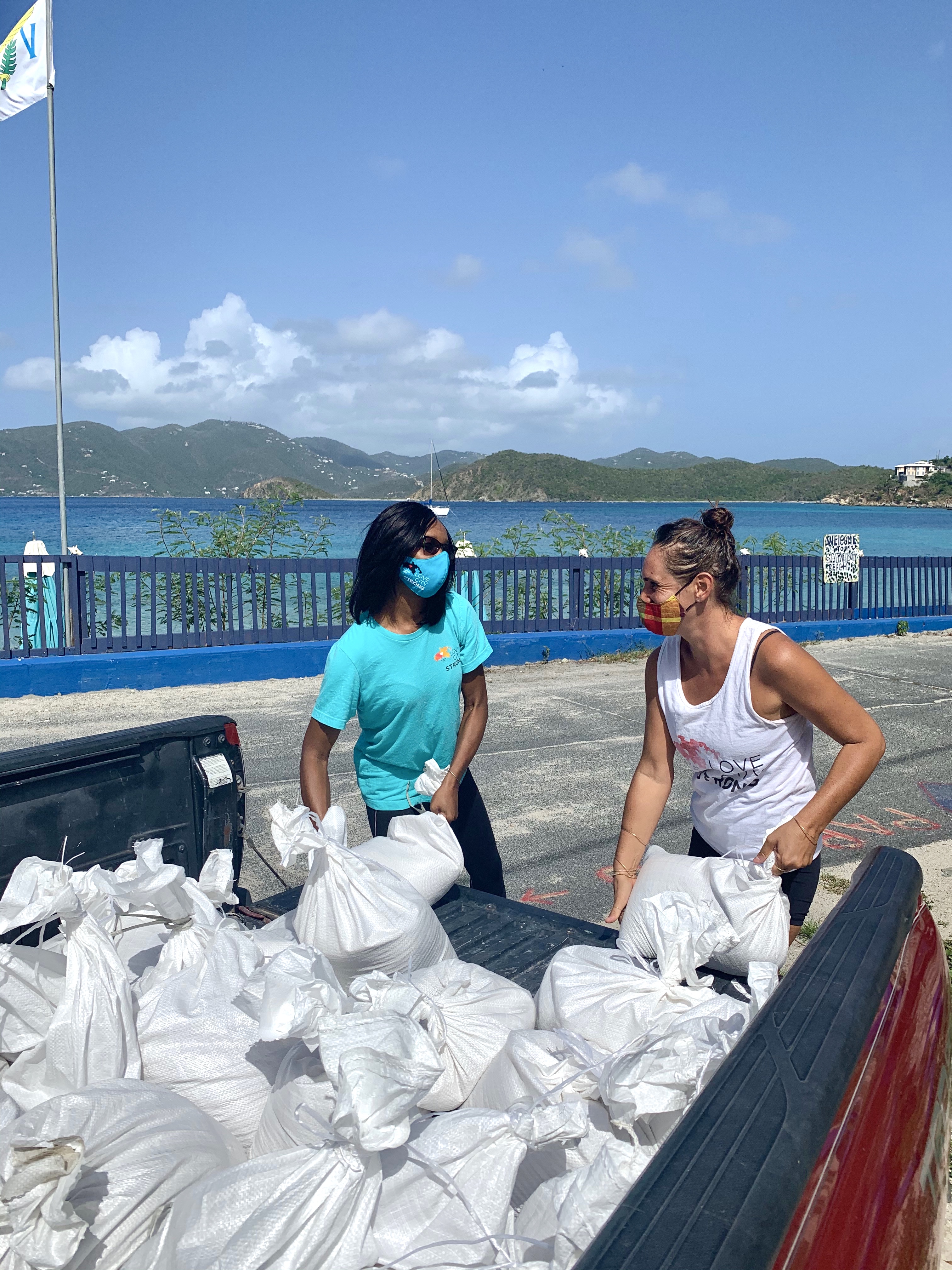
An active season has continued in the tropics throughout the month of August. Whether a season is “active” or not depends less on landfalls and more on the number of systems that are tracked throughout, and all coastal interests from the Caribbean to the southeast United States and the Gulf Coast have been aware of increasing activity in the Atlantic over the past several weeks. Love City Strong began monitoring Invest 98L on August 18th, and the next day NHC upgraded and began tracking tropical depression 13 (TD 13). The system was forecast to track directly over the U.S. Virgin Islands as a tropical storm, but took a more westerly course and the center of circulation ended up passing about 200 miles south of St Croix. Like TS Isaias, this was anticipated to be a fairly significant rain event, but St John recorded only about an inch of precipitation throughout the impact window, and the majority of the severe weather moved through during the early morning hours of Saturday, August 21st. No curfew was instituted, likely due to the fact that the Territory was under a COVID-19 related Stay at Home order at the time.
As usual, our team began regular meetings 72 hours prior to the projected Saturday impact. We continued these meetings until the morning of Sunday the 23rd – they were discontinued at that point due to the minimal impact of TS Laura on the Territory. On Monday the 24th, the Go Team proceeded with follow up calls to the High Risk wellness checklist.
Lessons from TS Isaias were implemented in our strategies, including earlier check ins within the organization to ensure personal preparedness at home. It became clear approximately 24 hours prior to the projected impact that TS Laura was going to stay well south of the U.S.V.I., but our team deployed as planned in the interest of continuity and routine practice. We believe our ability to pivot remains critical to a successful, efficient response, whether we’re facing a worse than anticipated impact or what amounts to simply a rainy day. We continue to fine tune the scalability of our programs from event to event, and know that each successfully executed cycle of deployment will further the community’s preparedness for whatever comes next. As we navigate the peak of 2020 hurricane season, we anticipate ever more opportunities to test the efficacy of our programs.
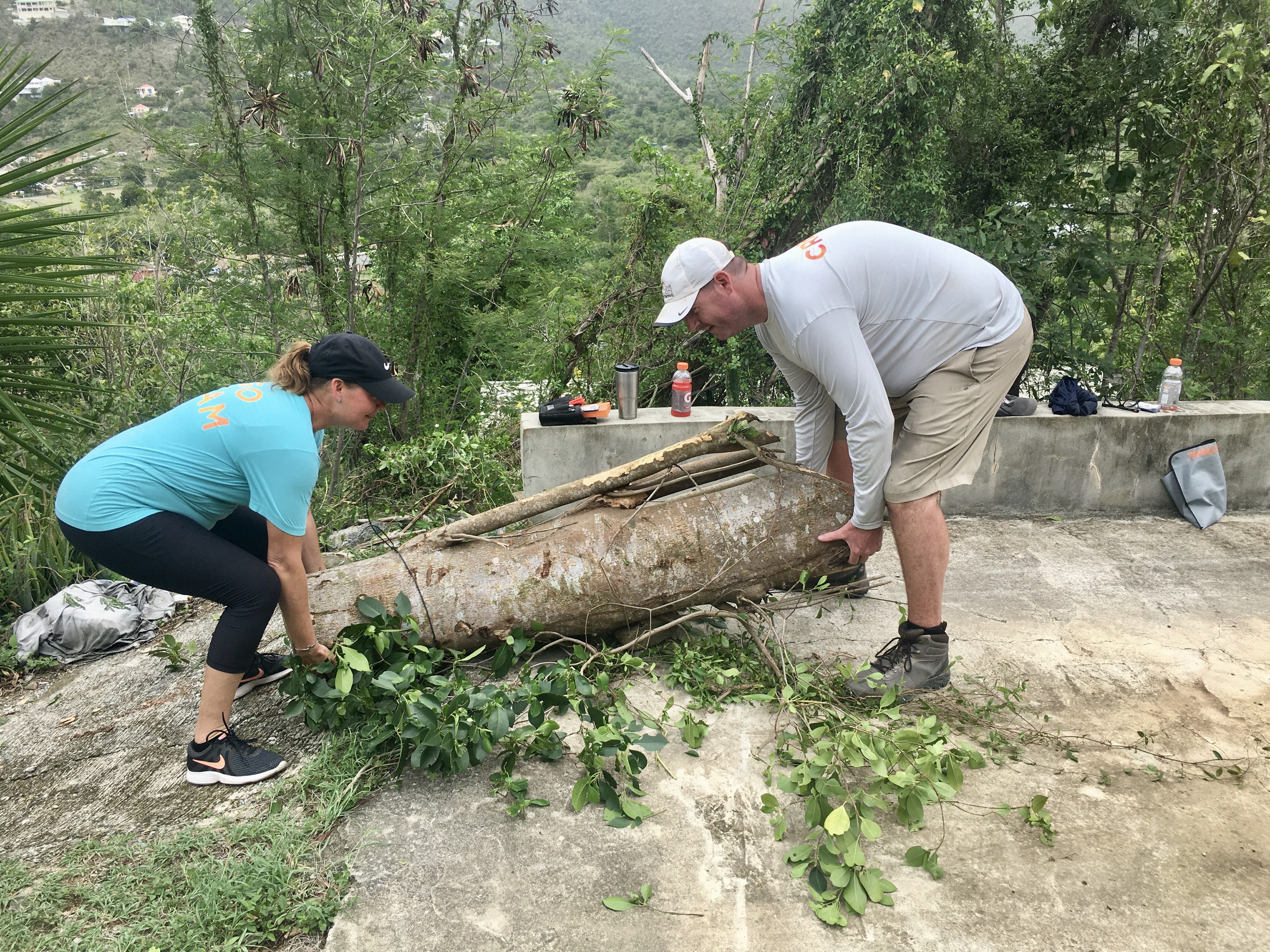
Each year as the month of July wanes, residents of the Virgin Islands begin to monitor the weather in the tropics more closely. The traditional peak of hurricane season won’t arrive until mid-September, but “early” storms are becoming more and more common as global weather patterns change.
On July 25th, the team at Love City Strong (LCS) began monitoring Invest 92L. Invests, also referred to as “areas of interest”, are numbered 90 through 99 and followed by the suffix letter “L” in the Atlantic Basin. The numbers are rotated throughout the season as often as needed. Invests are monitored for development by the NHC, and as they organize they escalate to a tropical depression, a tropical storm, a hurricane, or occasionally a potential tropical cyclone (PTC), in the case of an invest that is approaching land and requires forecasting but has not yet organized. Invest 92L was escalated to PTC 9 on July 28th, and the National Hurricane Center (NHC) began official forecasting for the system.
The large system moved quickly but did not manage to coalesce into Tropical Storm Isaias until the evening of July 29th, when it was passing the Territory to the south of St Croix. One of the paradoxes of hurricane season is that we’re almost always hoping a passing system will be a manageable but significant rain event, even as we pray to be spared a damaging impact. Tropical Storm Isaias did not deliver on this front, at least for St. John, as the center of circulation passed further to the south of the Territory than expected, limiting the amount of rain we received. The majority of the severe weather moved through St. John in the early hours of the 30th, and curfew was lifted Territory wide at 6 am.
Each storm that passes through the Territory serves as something of a fire drill. Our team uses these incidents as an opportunity to test our deployment plans, to adjust our response, and to identify weaknesses in existing operations and communications plans. In the case of Isaias, we executed routine briefings, morning and afternoon, throughout the week leading up to the system’s projected impact on our community, and in the days after. The Go Team began pre-impact wellness checks 48 hours before the weather was expected, and all LCS managed sites and assets were secured. The team stayed in close contact with the Virgin Islands Territorial Emergency Management Agency (VITEMA), the Federal Emergency Management Agency (FEMA), our Virgin Islands Voluntary Organizations Active in Disaster (VI VOAD) partners, and partnering organizations on St John throughout the incident.
After a storm passes, we gather the team to discuss the successes and failures of our response. Identifying the ways in which our plans failed, or underperformed is a critical part of developing our future programs, training, and community outreach. Each storm offers unique opportunities to test our various protocols and plans, and this year promises to offer more lessons than ever, as we layer a global pandemic atop the annual tropical weather threats.
When we recognize weaknesses, unmet needs, or challenges to our organizational routine the team collaborates to come up with next steps, potential solutions, and partners who may have valuable knowledge to contribute. Each storm is unique, and whether large or small, they each pose their own challenges.
Tropical Storm Isaias helped us streamline our incident log system and develop a more thorough follow up process on community requests. It crystalised the need for our LCS team to be proactive about our own preparedness, since we are often in the field in the days leading up to a storm, and may not have time to handle last minute preparations. It also provided us with an opportunity to clarify lines of communication and reporting structure within a disaster, as those sometimes differ from our day to day, “blue skies” structure.
Overall, the response to Tropical Storm Isaias was a valuable learning opportunity for the LCS team, and provided several critical takeaways. We identified points of friction in our systems, and developed actionable steps in place to remedy those. As we continue to experience impacts of varying size and complexity, our response will become increasingly scalable and effective.
